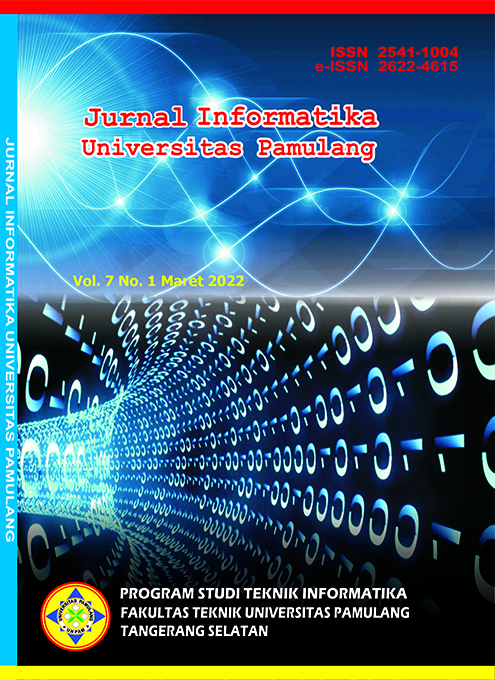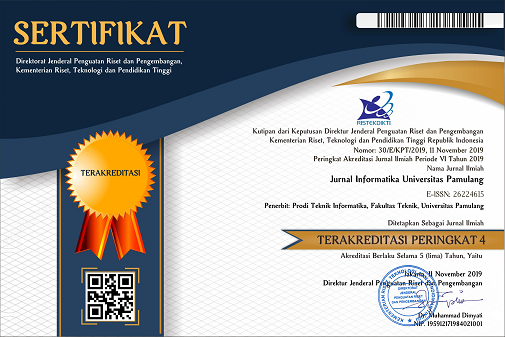Implementasi Algoritma Multiply With Carry Generator (MWCG) dalam Pengacakan Soal Ujian Semester Berbasis Web pada SMKN 1 Kendari
DOI:
https://doi.org/10.32493/informatika.v7i1.16125Keywords:
Multiply With Carry Generator, Randomness, Midterms, Runt TestAbstract
A semester exam conducted using google form on SMK 1 Kendari could be used as a loophole for cheating. It is requires a system that can randomize the question using specified algorithm. Multiply With Carry Generator algorithm is a simple interlinear numbers algorithm that can be used to solve this problem. In several previous studies, this algorithm has been widely used to generate random numbers in several programming applications. They are outgrown by the algorithm Multiply With Carry Generator, which is at the speed of generating random numbers and also the length of the randomness cycle produced by Multiply With Carry Generator, which uses two seeds to produce more seed variations. Based on testing runs perform to test the randomize of the algorithm Multiply With Carry Generator in 10 students with 20 numbers of question produce randomize question with test results received . It’s prove that Multiply With Carry Generator algorithm can be used to randomize the question and can be implemented in SMK 1 Kendari exam test system.
References
Arizqia, M. G., & Widodo, A. A. (2017). Rancang Bangun Aplikasi Dengan Linear Congruent Method (LCM) Sebagai Pengacakan Soal. JOINTECS (Journal of Information Technology and Computer Science), 2(1). https://doi.org/10.31328/jointecs.v2i1.412
Constantianus, F., & Suteja, B. (2005). Analisa dan Desain Sistem Bimbingan Tugas Akhir Berbasis Web dengan Studi Kasus Fakultas Teknologi Informasi. Jurnal Informatika, 1(2), 93–106.
Hartono, H. (2013). Pengertian Website dan Unsur-Unsurnya. Ilmu Teknologi Informasi (Ilmuti), 1–7.
Marsaglia, G. (2003). Random number generators. Journal of Modern Applied Statistical Methods, 2(1), 2–13. https://doi.org/10.22237/jmasm/1051747320
Mulya, Y. P., Latuconsina, R., Siswo, A., Ansori, R., Teknik, F., Telkom, U., Teknik, F., Telkom, U., Teknik, F., & Telkom, U. (2020). Implementasi Algoritma Multiply With Carry Pada Game Panahan Algorithm Implementation Of Multiply With Carry On. 7(1), 1464–1475.
Pramantya, Q. B. (2017). Analisis Kapabilitas Proses Pembuatan Batu Gamping Di CV. Anugerah Abadi Tuban. 62. http://repository.its.ac.id/41974/
Pratomo, A., & Mantala, R. (2016). Pengembangan Aplikasi Ujian Berbasis Komputer beserta Analisis Uji Guna Sistem Perangkat Lunaknya Menggunakan MEtode SUMI ( Software Usability Measurement Inventory ). Jurnal POSITIF, 2(1), 1–11.
Rivaldo, R., & Herriyance, H. (2021). Pengamanan Pesan Menggunakan Metode MLSB PRNG dan Kompresi File dengan Algoritma RLE pada File Audio. Jurnal Sistem Informasi Bisnis, 01, 1–8. https://doi.org/10.21456/vol11iss1pp1-8
Salesiano et al., “Implementasi Aplikasi Ujian Online Pada SMK PGRI 4 Kendal Menggunakan Framework Codeigniter†J. Chem. Inf. Model., vol. 53, no. 9, p. 6, 2021, [Online]. Available:http://dspace.ucuenca.edu.ec/bitstream/123456789/35612/1/TrabajodeTitulacion.pdf https://educacion.gob.ec/wpcontent/uploads/downloads/2019/01/GUIA-METODOLOGICA EF.pdf.
Samsuriati, N., Saputra, R. A., Pramono, B., Informatika, J. T., Teknik, F., Oleo, U. H., & Belakang, L. (2019). Aplikasi Ujian Toefl Menggunakan Metode Linear Congruential Generators ( Lcg ) Berbasis Web Pada. 233–242.
T. J. C. Sitanggang, T. L. (2016). Aplikasi Pengacak Soal Ujian Berkategori Menggunakan Metode LCM (Linear Congruent Method). MEANS (Media Informasi Analisa Dan Sistem), December 2016.
Downloads
Published
Issue
Section
License
Authors who publish with this journal agree to the following terms:
- Authors retain copyright and grant the journal right of first publication with the work simultaneously licensed under a Creative Commons Attribution-NonCommercial 4.0 International (CC BY-NC 4.0) that allows others to share the work with an acknowledgement of the work's authorship and initial publication in this journal.
- Authors are able to enter into separate, additional contractual arrangements for the non-exclusive distribution of the journal's published version of the work (e.g., post it to an institutional repository or publish it in a book), with an acknowledgement of its initial publication in this journal.
- Authors are permitted and encouraged to post their work online (e.g., in institutional repositories or on their website) prior to and during the submission process, as it can lead to productive exchanges, as well as earlier and greater citation of published work (See The Effect of Open Access).
Jurnal Informatika Universitas Pamulang have CC-BY-NC or an equivalent license as the optimal license for the publication, distribution, use, and reuse of scholarly work.
In developing strategy and setting priorities, Jurnal Informatika Universitas Pamulang recognize that free access is better than priced access, libre access is better than free access, and libre under CC-BY-NC or the equivalent is better than libre under more restrictive open licenses. We should achieve what we can when we can. We should not delay achieving free in order to achieve libre, and we should not stop with free when we can achieve libre.
Jurnal Informatika Universitas Pamulang is licensed under a Creative Commons Attribution-NonCommercial 4.0 International (CC BY-NC 4.0)
YOU ARE FREE TO:
- Share : copy and redistribute the material in any medium or format
- Adapt : remix, transform, and build upon the material for any purpose, even commercially.
- The licensor cannot revoke these freedoms as long as you follow the license terms





